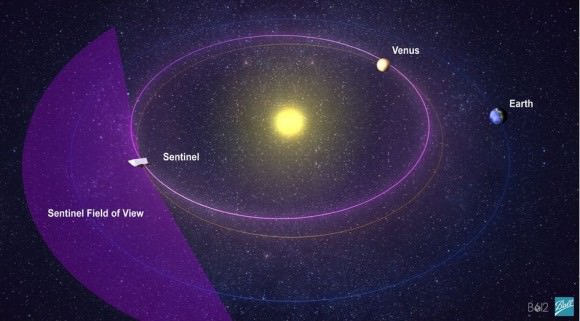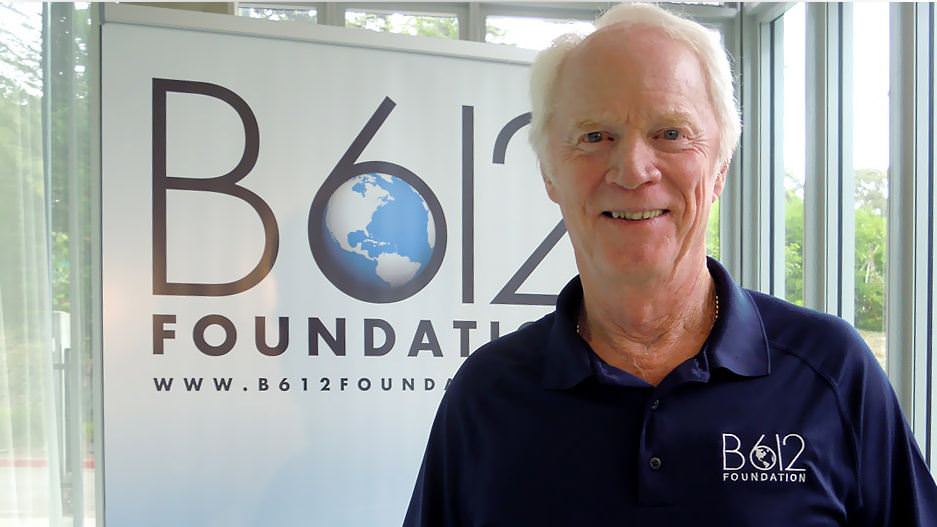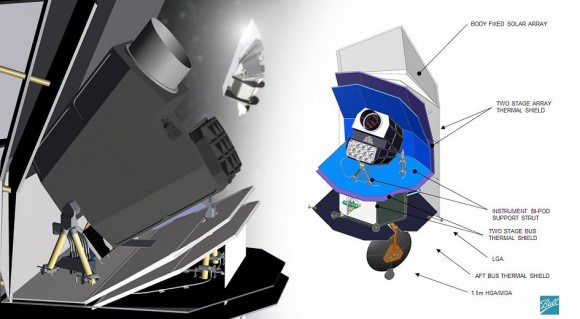The B612 Foundation announced in June of this year that it plans to launch the first privately funded deep space mission, a space telescope that will map the inner solar system’s asteroid population and chart their orbits over the next hundred years. The goal is to find every potentially Earth-impacting object out there.
“This is a very practical — and necessary — project,” Rusty Schweickart, Chairman Emeritus of B612, and Apollo 9 astronaut told Universe Today. “It can be done, it is exciting and we are trying to get the world to recognize that this is a great investment in the future of humanity.”

Caption: Sentinel’s field of view. Credit: B612 Foundation.
The spacecraft is called Sentinel, and it will be equipped with a 20.5-inch cryo-cooled infrared telescope that will scan for space objects such as asteroids and comets. It will be placed in orbit around the Sun, ranging up to 170 million miles from Earth, for its mission of discovery and mapping.
B612 Foundation is nonprofit group of scientists and explorers who advocate exploration of asteroids and monitoring of their trajectories to protect the Earth from potentially catastrophic impacts. Other notable members of the Foundation include space shuttle and International Space Station astronaut Ed Lu (B612’s CEO), project architect Scott Hubbard, a Stanford professor who once served as the head of NASA’s Mars’ missions, and mission director Harold Reitsema, former director of space science missions at Ball Aerospace.
The foundation is named after the asteroid in Antoine de Saint-Exupery’s story “The Little Prince” which brought the young prince to various destinations, and originally the B612 Foundation focused on determining the best ways for deflecting a potential incoming asteroid. But it has since shifted its focus to the current project which involves only identifying dangerous near-Earth objects.
Read a new article, “Chasing the Little Prince in New York City”
“We have been working this issue for a number of years,” Schweickart said via phone, “and finding these asteroids is the next step that everyone agrees needs to be done.”
Schweickart said for years, the expectations were that NASA would be doing a project like this.
“But you know the situation in Washington,” he said. “With NASA’s budgeting outlook and the priorities NASA currently has, it doesn’t appear like this is something NASA could get to for a long time. We decided that, given what is going on with privatizations and with launch costs coming down, this was something on the scale that could be privately these days. And in recognizing the delay of not doing it ourselves, we decided to give it a go.”
While NASA’s Near-Earth Object program is scanning the skies and has found nearly 10,000 objects, or about 90 percent of the estimated objects larger than a half-mile across, according to B612, there are a half million more asteroids larger than the one that devastated the Tunguska region in northern Russia in 1908. Of those, only one percent has been mapped.
Schweickart said the launch of Sentinel would be a seminal step.
“It is the big step to locate almost all the objects of a size that can really do damage on the surface,” he said. “In five and a half years, we can meet very rapidly the goal of 90% of 140-meter-wide objects. But going down to the smaller ones that can still do damage, like the size of Tunguska, we should have about 50% of those that five and a half years. If we end up with an extended mission, which we’d definitely like to do, we should get to 60-70% completion of objects down to 40 meters.”
That would put over 500,000 objects in the Near Earth Object database, and Scheickart said, “the nice thing about asteroids is that once you’ve found them and once you have a good solid orbit on them you can predict a hundred years ahead of time whether there is a likelihood of an impact with the Earth.”
The Sentinel spacecraft is being built by Ball Aerospace and has been described as a mash-up of the Spitzer and Kepler space telescopes, both also designed by Ball. It’s wide-field, 24-million-pixel view should be able to map asteroids down to 40 meters.
B612 is targeting launch for 2017-2018, and their launch vehicle of choice is the SpaceX Falcon9.
Schweickart said Ball Aerospace has been working on the concept and design of this type of telescope for several years. “And we’ve been working with them on a daily basis for over a year now, so we are pretty confident that they can build this and we can launch and operate it,” he said, “but the new part of the challenge is raising the money.”
Currently B612 has specialists working on their funding, “and that is sufficient for now,” Schwieckart said. “As we move forward the costs will dramatically increase, no question. When you start bending metal and building spacecraft, and buying launch services you are talking a few hundred million dollars. But with anything like this, you raise that in stages.”
Since the announcement of the Sentinel mission comes closely on the heels of the Planetary Resources’ announcement of their own plans to privately travel to asteroids to mine them for minerals, Universe Today asked Schweickart to compare the Sentinel to Planetary Resource’s plans.
“Their plan is completely different,” Schweickart said. “We don’t have any relationship with them, but we’ve certainly talked with them. They are interested in developing resources from asteroids, and doing specific site surveillance of particular asteroids that they might want to use for resource development. But they have to know where to go. And our job is to find asteroids and map this territory – which is basically a region like a ‘donut’ around the Earth, so Planetary Resources will be consulting our maps, as many other people will, as well.”
And Schweickart added, “Our project has nothing to do with profit or investment for payback. This is for the survival and the benefit of humanity – everyone on Earth.”
But Schweickart called this territory of asteroids “the new frontier,” and protecting Earth is not the only reason for mapping asteroids. “It is not just planetary defense, it is also resources in the future, and places for human exploration, and it is science as well. We are going to end up with a map that can be used by many people.”
How difficult will it be for the Sentinel mission to be successful?
“You are talking to a technologist,” Schweickart said with a chuckle. “To me the technology is pretty straightforward, and we’ve got that pretty much in hand. But it is a different kind of project than what has been done before, so that is where the challenge lies. But I think this will be a very exciting process.”
For more information on the B612 Foundation and the Sentinel project and how you can donate, see the B612 Foundation website, or watch the video below.


